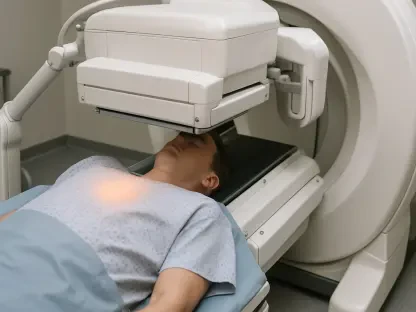The National Health Service (NHS) currently faces a formidable obstacle in addressing an entrenched workforce challenge within radiology departments, a dilemma underscored by findings from the U.K. Royal College of Radiologists (RCR). With reports painting a grim picture of staff shortages, these deficits are not just numbers on paper. They hold significant weight in dictating the quality of patient care and the operational efficacy of the health service. More than just a logistical problem, the crisis has far-reaching implications on the speed and accuracy of diagnoses and treatments, crucial components of effective healthcare. The reliance on insourcing and outsourcing to make up for insufficient staffing levels has become more pronounced, signaling the urgency of a sustainable solution.
Surge in Insourcing and Outsourcing
The crisis in radiology staffing is exemplified by the increased dependence on insourcing and outsourcing, with reports indicating that no radiology department in the United Kingdom can meet its reporting obligations within standard working hours. Insourcing involves compensating existing staff for overtime work, while outsourcing entails engaging third-party companies to handle radiological reporting. As of the current year, an overwhelming majority of radiology departments resort to these methods, with 97% utilizing insourcing and 95% outsourcing some of their workload. While larger departments show a tendency toward insourcing, smaller departments lean on outsourcing to manage their workload. The prominence of external solutions reflects a strategic necessity amidst workforce shortages. This growing dependency models an interim response rather than a long-term strategy, as ongoing reliance implies escalating costs and potential risks to service continuity.
The Financial Impact
Financial repercussions of this escalating outsourcing are substantial, with NHS trusts and health boards witnessing a significant rise in expenditures associated with these services. In the present year, expenditure is projected to reach £325 million, reflecting a 16% increase from the previous year. Should the current trajectory persist, this figure could soar to £547 million over the next five years. These expenditures highlight the critical nature of the crisis, as this financial drain parallels the salaries of nearly 2,910 consultant radiologists. The growing expenses serve as a reminder of the pressing need for innovative strategies to strengthen in-house capabilities and rectify reliance on outsized external resources. Any potential solution must have financial sustainability as a core component, balancing immediate service needs with long-term fiscal responsibility.
Retention and the Shift Toward Part-Time Work
Another aspect of the staffing issue reveals itself through a retention crisis, as senior radiologists are leaving earlier than before. The median age for departure has decreased, shifting from 55 to 50. Furthermore, a surprising 40% of those exiting are under 45, exacerbating the scarcity of experienced professionals and signaling a need for reforms. Alongside this, the trend toward less than full-time employment is rising, with 39% of the workforce now adopting this work model. This pattern illustrates a growing preference for work-life balance or diversifying professional commitments, such as family obligations or positions in teleradiology. Particularly among radiologists over 50, this trend is prominent, while only 26% of those under 40 follow suit. Adapting policies to retain radiologists within the NHS while accommodating flexible work arrangements could be crucial in mitigating workforce issues.
Challenges in AI Adoption and Staffing for New Equipment
The exploration of technological solutions, particularly through Artificial Intelligence (AI), reveals mixed outcomes. AI’s potential to streamline processes has not yet translated into decreased workloads for clinicians, as many report negligible change or even higher burdens due to adjustments needed for its integration. This points to the complexities involved in adopting new technologies as immediate solutions to staffing woes. Similarly, the dearth of suitable radiographers and radiologists persists as a hindrance to effectively employing new diagnostic equipment. Without the human resources necessary for operation and integration, even increased equipment allocations cannot reach their full operational potential. The bottleneck caused by insufficient manpower not only affects current service capabilities but also limits future growth in diagnostic competence, indicating a need for a parallel investment in human capital alongside technological advancements.
Gender Disparities and Specialty Attrition
Gender representation in radiology, particularly in interventional radiology (IR), presents another dimension of concern. While women now constitute 42% of diagnostic consultant radiologists, their representation in IR remains a mere 12%. This disproportionate participation highlights underlying recruitment and retention challenges that may worsen an already pressing demand for specialists such as interventional neuroradiologists, whose demand has risen by 7.9% but remains unmet. Coupled with this are high anticipated retirement rates in specialties like chest, lung, and breast radiology, suggesting an urgent need to consider the temporary uneven distribution of radiologists across specialties. Meanwhile, certain areas like uroradiology, cardiac, and head and neck radiology show growth, indicating a chance for strategic realignment in training and recruitment, possibly by targeting these emerging interests and distributing resources more equitably across specializations.
Toward Strategic Solutions
The RCR findings spotlight the criticality of adopting strategic interventions and policies focused on workforce enhancement, retention, and optimal resource utilization. Addressing retention issues through innovative workforce strategies, advancing AI integration, and addressing gender disparities in specialty recruitment all form parts of a multifaceted approach. Among the loudest criticisms are those directed toward past governmental inaction, as advocates argue that longstanding warnings have been inadequately addressed. Dr. Paul McCoubrie, among others, posits that a greater urgency in advocacy is necessary to draw political and media attention. Rebranding radiology from a “Cinderella” specialty to a foundational pillar of healthcare could potentially heighten its priority within national health discussions. The complex nature of these issues demands a comprehensive and coordinated strategy moving forward.
Reimagining the Future of Radiology
Synthesizing these insights suggests that overcoming the radiology staffing crisis requires more than short-term fixes. While augmenting personnel is necessary, a deeper reevaluation of radiology’s societal and professional standing is imperative, incorporating advancements in training, technology, and public policy measures. Future directions should target integrating AI more effectively to support, rather than burden, clinical operations and advocate for equitable gender representation across specialties, fostering a diversified pool of talent. Engendering solutions that align with modern healthcare demands will be instrumental in ensuring radiology’s critical role within the NHS is upheld and expanded. A concerted effort to innovate and adapt can transform this crisis into an opportunity for systemic improvements in healthcare delivery.









